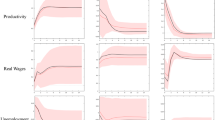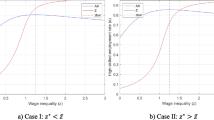Abstract
This paper develops a two-region two-sector endogenous growth model with a dual labour market based on efficiency wages. Growth is driven by research done in the (high-tech) tradeables sector. The follower region tends to catch up in terms of labour productivity with the leader region. Differences in unemployment compensation systems can lead to relative convergence, i.e., a steady state with the backward region lagging behind the leader region. The reason for this is that high social welfare compensations generate high unemployment and reduce the amount of labour employed for R&D purposes.
Similar content being viewed by others
REFERENCES
Aghion, Ph. and P. Howitt (1994), 'Growth and Unemployment,' Review of Economic Studies, 61, pp. 477–494.
Akerlof, G.A. (1982), 'Labor Contracts as Partial Gift Exchange,' Quarterly Journal of Economics, 97, pp. 543–569.
Akerlof, G.A. and J.L. Yellen (1986), 'Introduction,' in: G.A. Akerlof and J.L. Yellen (eds.), Efficiency Wage Models of the Labor Market, Cambridge, Cambridge University Press, pp. 1–21.
Ark, B. van and D. Pilat (1993), 'Productivity Levels in Germany, Japan, and the United States: Differences and Causes,' Brookings Papers on Economic Activity: Microeconomics, 2, pp. 1–64.
Barro, R.J. and X. Sala-i-Martin (1995), Economic Growth, New York, McGraw-Hill.
Bean, Ch. and N. Crafts (1995), British Economic Growth since 1945: Relative Economic Decline... and Renaissance?, CEPR Discussion Paper 1092, London.
Bean, Ch. and Chr. Pissarides (1993), 'Unemployment, Consumption and Growth,' European Economic Review, 37, pp. 837–859.
Bean, Ch.R. (1994), 'European Unemployment: A Survey,' Journal of Economic Literature, 32, pp. 573–619.
Brezis, E., P. Krugman, and D. Tsiddon (1991), Leapfrogging: A Theory of Cycles in National Technological Leadership, NBER Working Paper 3886, Cambridge, MA.
Brown, Ch. and J. Medoff (1989), 'The Employer Size-Wage Effect,' Journal of Political Economy, 97, pp. 1027–1059.
Bulow, J.I. and L.H. Summers (1986), 'A Theory of Dual Labor Markets with Application to Industrial Policy, Discrimination, and Keynesian Unemployment,' Journal of Labor Economics, 4, pp. 376–414.
Burda, M. (1988), ' ''Wait Unemployment'' in Europe,' Economic Policy, 7, pp. 391–425.
Coe, D.T. and E. Helpman (1995), 'International R&D Spillovers', European Economic Review, 39, pp. 859–887.
Dixit, A. and J.E. Stiglitz (1977), 'Monopolistic Competition and Optimum Product Diversity,' American Economic Review, 67, pp. 297–308.
Dollar, D. and E.N. Wolff (1993), Competitiveness, Convergence, and International Specialization, Cambridge, MA, MIT Press.
Dosi, G. (1988), 'Sources, Procedures, and Microeconomic Effects of Innovation,' Journal of Economic Literature, 26, pp. 1120–1171.
Fagerberg, J. (1994), 'Technology and International Differences in Growth Rates,' Journal of Economic Literature, 32, pp. 1147–1175.
Gera, S. and G. Grenier (1994), 'Interindustry Wage Differentials and Efficiency Wages: Some Canadian Evidence,' Canadian Journal of Economics, 27, pp. 81–100.
Gerschenkron, A. (1952), 'Economic Backwardness in Historical Perspective,' in: B.F. Hoselitz (ed.), The Progress of Underdeveloped Areas, Chicago, University of Chicago Press.
Kahneman, D., J.L. Knetsch, and R. Thaler (1986), 'Fairness as a Constraint on Profit Seeking: Entitlements in the Market', American Economic Review, 76, pp. 728–741.
Katz, L.F. (1986), 'Efficiency Wage Theories: A Partial Evaluation,' in: S. Fischer (ed.), NBER Macroeconomics Annual 1986, pp. 235–289.
Klundert, Th. van de and S. Smulders (1996), 'North-South Knowledge Spillovers and Competition. Convergence versus Divergence,' Journal of Development Economics, 50, pp. 213–232.
Krueger, A.B. and L.H. Summers (1988), 'Efficiency Wages and the Inter-industry Wage Structure,' Econometrica, 56, pp. 259–293.
Krugman, P.R. (1990), Rethinking International Trade, Cambridge, MA, MIT Press.
Layard, R., St. Nickell, and R. Jackman (1991), Unemployment, Macroeconomic Performance and the Labour Market, Oxford, Oxford University Press.
Lindbeck, A. and D.J. Snower (1991), Segmented Labour Markets and Unemployment, CEPR Discussion Paper 523. London.
Maddison, A. (1995), Monitoring the World Economy 1820–1992, Paris, OECD Development Centre Studies.
Mankiw, N.G. (1995), 'The Growth of Nations', Brookings Papers on Economic Activity, 22, pp. 271–326.
McKinsey Global Institute (1996), Capital Productivity, McKinsey and Company, Washington D.C.
Mueller, D.C. (1986), Profits in the Long Run, Cambridge, Cambridge University Press.
OECD (1993), The International Sectoral Database, Paris.
OECD (1994), The OECD Jobs Study; Evidence and Explanations, parts I and II, Paris.
Olson, M. (1996), 'Big Bills Left on the Sidewalk: Why Some Nations are Rich, and Others Poor,' Journal of Economic Perspectives, 10, pp. 3–24.
Pasinetti, L.L. (1981), Structural Change and Economic Growth, A Theoretical Essay on the Dynamics of the Wealth of Nations, Cambridge, Cambridge University Press.
Salop, S.C. (1979), 'A Model of the Natural Rate of Unemployment,' American Economic Review, 69, pp. 117–125.
Schaik, A.B.T.M. van and H.L.F. de Groot (1995), Unemployment and Endogenous Growth, CentER Discussion Paper 9575, Tilburg.
Shapiro, C. and J.E. Stiglitz (1984), 'Equilibrium Unemployment as a Worker Discipline Device,' American Economic Review, 74, pp. 433–444.
Solow, R.M. (1980), 'On Theories of Unemployment,' American Economic Review, 70, pp. 1–11.
Summers, R. and A. Heston (1991), 'The Penn World Table (Mark 5): An Expanded Set of International Comparisons, 1950–1988,' Quarterly Journal of Economics, 106, pp. 327–368.
Weiss, A. (1980), 'Job Queues and Layoffs in Labor Markets with Flexible Wages', Journal of Political Economy, 88, pp. 526–538.
Author information
Authors and Affiliations
Rights and permissions
About this article
Cite this article
De Groot, H.L., Van Schaik, A.B. Unemployment and Catching Up: Europe Vis-à-vis the USA. De Economist 145, 179–201 (1997). https://doi.org/10.1023/A:1002990104412
Issue Date:
DOI: https://doi.org/10.1023/A:1002990104412




